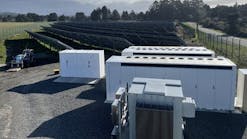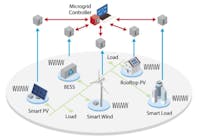In support of California’s goals for 100% carbon-free electricity, grid reliability and climate resilience, San Diego Gas & Electric (SDG&E) and Sumitomo Electric (SEI) undertook and successfully completed a zero-emissions microgrid pilot project using a vanadium redox flow (VRF) battery – the first of its kind to be connected to the state’s energy market in 2018.
Developing zero-emissions microgrids powered with long-duration energy storage has become a top priority for California, as growing wildfire risks have led to more frequent use of Public Safety Power Shutoffs (PSPS). Microgrids are mini power grids that can operate independently of the larger grid and keep critical facilities powered during emergencies and PSPS.
In one of the test runs, the 2MW/8MWh VRF battery — functioning as part of a microgrid — powered 66 residential and commercial customers for close to five hours.
“Climate conditions increasingly threaten the continuity of essential services that our customers expect and deserve from us, which is one of the many reasons we are so focused on innovation and technology,” said Caroline Winn, CEO, SDG&E. “There is a critical need to develop breakthrough solutions like zero-emissions microgrids to not only minimize disruptions, but to also support the transition to a cleaner, safer and more reliable energy grid of the future.”
Different from more prevalent stacked lithium-ion battery cells, VRF batteries consist of tanks of liquid electrolytes and pumps that charge and discharge electrons to the grid. During the pilot, the batteries charged when solar energy was abundant and discharged during peak hours to meet demand.
Following the 2015 signing of a Memorandum of Understanding between Japan’s New Energy and Industrial Technology Development Organization (NEDO) and the California Governor’s Office of Business and Economic Development (GO-Biz), the flow battery was installed at SDG&E’s substation in Bonita, CA in 2017 as part of a collaboration between SDG&E and SEI with project funding provided by NEDO.
“California already has the highest concentration of lithium-ion battery storage in the world, which has proven to be a game-changer at critical times of stress on the grid,” said Peter Klauer, senior advisor, Smart Grid Technology, at the California Independent System Operator. “It’s inspiring now to see other storage technologies emerge, creating more opportunities to balance and manage power grids. We are excited to understand the specific capabilities of VRF technology and will continue to evolve our market design to further support grid integration of energy storage technologies.”
“While climate change presents many challenges, it also spurs innovations that can lead to new industries and good, family-supporting jobs,” said Dee Dee Myers, director, GO-Biz. “We are proud to be part of this international collaboration, which is a great example of Japan’s continued position as the top source of foreign investment in California and a demonstration of how that investment brings new opportunities both here at home and abroad.”
"It is a great honor for NEDO to successfully complete the demonstration project through our collaborative relationship with the State of California. We are grateful to our project partners at GO-Biz, SDG&E, and Sumitomo Electric for their many contributions,” said Shuji Yumitori, executive director, NEDO . “The microgrid project shows flow batteries are an innovative technology that can prevent blackouts caused by natural disasters, such as wildfires, improve grid resiliency and integrate large amounts of renewable energy. NEDO looks forward to continuing to support clean energy innovation in California and around the world."
The microgrid demonstration project was completed late last year and included two successful tests. One was a seamless transition in which customers did not experience any loss of power when they were transitioned to the microgrid for electric service. The other was a black start — meaning microgrid operators established and sustained service after a complete loss of power. Customers experienced a momentary outage before they were transitioned to the microgrid, which operated in island mode separate from the larger power grid. Tests were conducted during variable weather conditions. Even on a cloudy day when solar power output was lower, the microgrid provided essential energy service.


